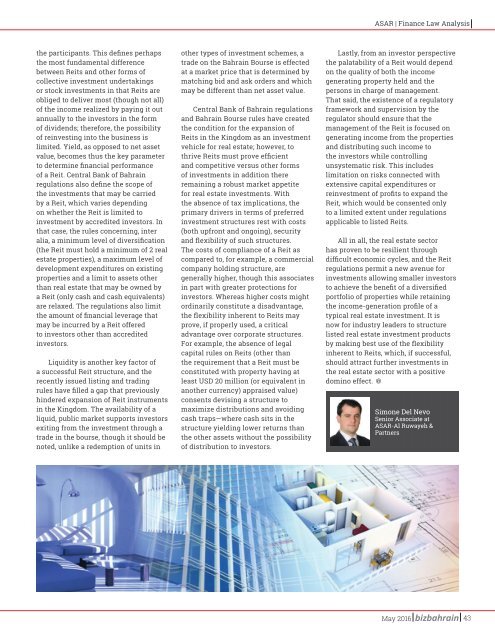BizBahrain April 2016
Create successful ePaper yourself
Turn your PDF publications into a flip-book with our unique Google optimized e-Paper software.
ASAR | Finance Law Analysis<br />
the participants. This defines perhaps<br />
the most fundamental difference<br />
between Reits and other forms of<br />
collective investment undertakings<br />
or stock investments in that Reits are<br />
obliged to deliver most (though not all)<br />
of the income realized by paying it out<br />
annually to the investors in the form<br />
of dividends; therefore, the possibility<br />
of reinvesting into the business is<br />
limited. Yield, as opposed to net asset<br />
value, becomes thus the key parameter<br />
to determine financial performance<br />
of a Reit. Central Bank of Bahrain<br />
regulations also define the scope of<br />
the investments that may be carried<br />
by a Reit, which varies depending<br />
on whether the Reit is limited to<br />
investment by accredited investors. In<br />
that case, the rules concerning, inter<br />
alia, a minimum level of diversification<br />
(the Reit must hold a minimum of 2 real<br />
estate properties), a maximum level of<br />
development expenditures on existing<br />
properties and a limit to assets other<br />
than real estate that may be owned by<br />
a Reit (only cash and cash equivalents)<br />
are relaxed. The regulations also limit<br />
the amount of financial leverage that<br />
may be incurred by a Reit offered<br />
to investors other than accredited<br />
investors.<br />
Liquidity is another key factor of<br />
a successful Reit structure, and the<br />
recently issued listing and trading<br />
rules have filled a gap that previously<br />
hindered expansion of Reit instruments<br />
in the Kingdom. The availability of a<br />
liquid, public market supports investors<br />
exiting from the investment through a<br />
trade in the bourse, though it should be<br />
noted, unlike a redemption of units in<br />
other types of investment schemes, a<br />
trade on the Bahrain Bourse is effected<br />
at a market price that is determined by<br />
matching bid and ask orders and which<br />
may be different than net asset value.<br />
Central Bank of Bahrain regulations<br />
and Bahrain Bourse rules have created<br />
the condition for the expansion of<br />
Reits in the Kingdom as an investment<br />
vehicle for real estate; however, to<br />
thrive Reits must prove efficient<br />
and competitive versus other forms<br />
of investments in addition there<br />
remaining a robust market appetite<br />
for real estate investments. With<br />
the absence of tax implications, the<br />
primary drivers in terms of preferred<br />
investment structures rest with costs<br />
(both upfront and ongoing), security<br />
and flexibility of such structures.<br />
The costs of compliance of a Reit as<br />
compared to, for example, a commercial<br />
company holding structure, are<br />
generally higher, though this associates<br />
in part with greater protections for<br />
investors. Whereas higher costs might<br />
ordinarily constitute a disadvantage,<br />
the flexibility inherent to Reits may<br />
prove, if properly used, a critical<br />
advantage over corporate structures.<br />
For example, the absence of legal<br />
capital rules on Reits (other than<br />
the requirement that a Reit must be<br />
constituted with property having at<br />
least USD 20 million (or equivalent in<br />
another currency) appraised value)<br />
consents devising a structure to<br />
maximize distributions and avoiding<br />
cash traps—where cash sits in the<br />
structure yielding lower returns than<br />
the other assets without the possibility<br />
of distribution to investors.<br />
Lastly, from an investor perspective<br />
the palatability of a Reit would depend<br />
on the quality of both the income<br />
generating property held and the<br />
persons in charge of management.<br />
That said, the existence of a regulatory<br />
framework and supervision by the<br />
regulator should ensure that the<br />
management of the Reit is focused on<br />
generating income from the properties<br />
and distributing such income to<br />
the investors while controlling<br />
unsystematic risk. This includes<br />
limitation on risks connected with<br />
extensive capital expenditures or<br />
reinvestment of profits to expand the<br />
Reit, which would be consented only<br />
to a limited extent under regulations<br />
applicable to listed Reits.<br />
All in all, the real estate sector<br />
has proven to be resilient through<br />
difficult economic cycles, and the Reit<br />
regulations permit a new avenue for<br />
investments allowing smaller investors<br />
to achieve the benefit of a diversified<br />
portfolio of properties while retaining<br />
the income-generation profile of a<br />
typical real estate investment. It is<br />
now for industry leaders to structure<br />
listed real estate investment products<br />
by making best use of the flexibility<br />
inherent to Reits, which, if successful,<br />
should attract further investments in<br />
the real estate sector with a positive<br />
domino effect.<br />
Simone Del Nevo<br />
Senior Associate at<br />
ASAR-Al Ruwayeh &<br />
Partners<br />
May <strong>2016</strong><br />
43

















